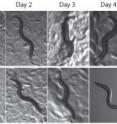Mating is the kiss of death for certain female worms
The presence of male sperm and seminal fluid causes female worms to shrivel and die after giving birth, Princeton University researchers reported this week in the journal Science. The demise of the female appears to benefit the male worm by removing her from the mating pool for other males. The researchers found that male sperm and seminal fluid trigger pathways that cause females to dehydrate, prematurely age and die.
"Their lifespans are cut by about a third to a half," said senior author Coleen Murphy, an associate professor of molecular biology and the Lewis-Sigler Institute for Integrative Genomics.
The death of the female after she gives birth fits into a general framework of sperm competition that has been observed often in nature, said Murphy. "Males compete to have their genomes propagated, and this often occurs at the expense of the female."
Shortened female lifespans following mating have been observed before for roundworms, but the study is the first to document the body shrinkage and identify the underlying biological pathways, Murphy said.
"The fact that sex essentially kills the mothers after they have produced the males' progeny has never been reported before and is shocking to most people who hear this story for the first time, including researchers who study these worms," Murphy said.
Over the course of seven days, females who have mated shrivel up and die, whereas females who have not mated remain healthy.
The team found that the pathways by which the male kills the female are ones that researchers think exist for the purpose of slowing down aging during times of low nutrients.
"The males are taking these pathways and running them in reverse, causing the acceleration of aging and death," Murphy said.
The researchers discovered the effect in the Caenorhabditis elegans (C. elegans) roundworm, which is found in soil and rotting fruit and is about the size of a piece of lint. The roundworm is commonly used in research because many of its genetic pathways are similar to those of humans.
"That these pathways can be hijacked and run in reverse in a simple organism might suggest that that could also happen in more complex organisms," said Murphy. "So the work can help us understand male-female interactions and how they influence female longevity and reproduction."
Normally the females of the species C. elegans have no need for males, Murphy explained, because they are hermaphrodites -- their bodies contain both sperm and egg cells so they can reproduce without coming in contact with males.
"The hermaphrodites try to avoid the males -- they will try to sprint away from them. The males have to hunt them down to get them to mate," said Murphy.
Males, however, require females if they are to pass on their genes to future generations. Once inseminated, the female can give birth to hundreds of progeny, and these offspring do not require maternal care after they are born. Killing off the mother makes her unavailable to mate with other males, giving a genetic advantage to the father.
Graduate student Cheng Shi, lead author on the paper, discovered the effect unexpectedly while carrying out studies to look at the effect of aging on reproductive health. He was conducting experiments that required him to mate female and male worms.
"I saw a dramatic reduction in the size of the females," said Shi, "so I started taking additional images and measuring the effect." Shi began exploring how the sperm or its surrounding seminal fluid could cause the shrinkage and death.
He discovered that seminal fluid acts on a biological process that helps the worms conserve energy during times of stress. The seminal fluid acts on a transcription factor, or protein, called DAF-16 in the nucleus of cells that turns on the genes necessary to respond to stresses such as heat or low nutrients. In mated females, the factor is somehow driven out of the nucleus so it cannot activate the stress response system, causing fat loss and lifespan decrease.
Sperm acts via another mechanism to shorten longevity, Shi found. The sperm causes the shut-off of a factor called DAF-9 that activates a separate nuclear hormone stress response pathway involving another molecule called DAF-12, leading to water loss, shrinking and shortened lifespan.
The researchers found that the lethal effect occurred not only in the elegans species but also in other types of worms from the Caenorhabditis genus that are not hermaphroditic. "The fact that it is conserved in true male-female species, not just hermaphrodites, suggests that it is an important, conserved biological mechanism," Murphy said. Although it is not yet known whether sperm and seminal fluid also kill other animals after mating, the longevity pathways involved are conserved in other organisms.
"Our results indicate that there are factors in seminal fluid and sperm that shut off these two stress-response mechanisms," Murphy said. "It is a one-two punch, with two independent pathways that males use to kill the females."
Source: Princeton University
Other sources
- Mating is kiss of death for certain female wormsfrom Science DailyFri, 20 Dec 2013, 2:00:30 UTC
- Mating is the kiss of death for certain female wormsfrom PhysorgThu, 19 Dec 2013, 21:00:36 UTC
